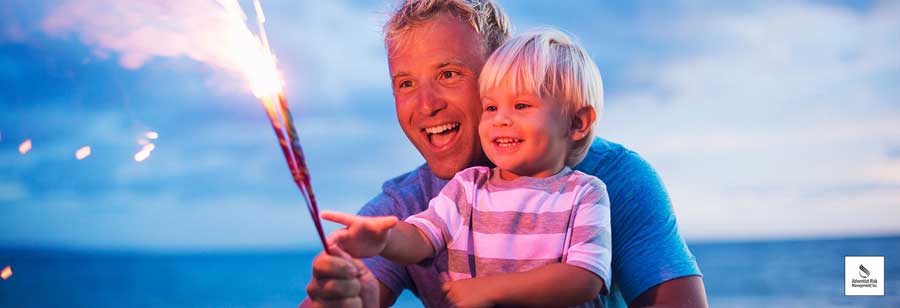The Fourth of July or Independence Day—a national holiday observed in the United States—is always filled with nostalgia for me. My childhood home included a sizable back deck that was the scene of many a summer cookout or barbecue. On Independence Day, my parents would roll out a fantastic spread, including hot dogs and burgers done up on the grill, homemade coleslaw and potato salad dished up on the side, and my mother’s banana pudding for dessert. Then came the fireworks.
My dad set up the fireworks in the middle of the yard, lit them, and then backed away a safe distance before sparks erupted. The fireworks flew up into the air with a loud CRACK, showering sparkles and lights as it went.
The night ended with each one of us tucked away safely in bed. Sadly, many people end their holiday celebrations with a visit to the emergency room because of a fireworks burn or accident.
- More than 10,000 people received fireworks-related injuries in 2014
- 230 people on average visit the emergency room every day with a fireworks-related injury in the month surrounding July 4th, according to the United States Consumer Product Safety Commission (USCPSC).
- More than 3,000 children under the age of 15 visit the emergency room annually in the United States because of fireworks, according to the global organization SafeKids.org.
1.Check the Fine Print
Confirm accident and property damage coverage with your conference. Does your insurance company provide any guidelines for a safe fireworks show?2.Don’t Break the Law
Regulations vary on fireworks usage in different locales. Large reloadable mortar shells, cherry bombs, aerial bombs, M-80 salutes, and larger firecrackers containing more than two grains of powder are illegal in the United States. Know what is legal to use in your area before you buy, and follow all local laws.In the United States, learn the Fireworks Regulations in your state through the American Pyrotechnics Association.
3.Set Up for Success
Starting with a safe environment goes a long way to prevent accidents from happening. Set aside a clear area, away from buildings and vehicles, to launch the fireworks. Most fireworks-related claims submitted to ARM are due to fireworks launched too close to a building, landing on and damaging the roof. Keep a bucket of water or garden hose near the launching area to put out accidental fires. Create a parameter around the launching area and only allow authorized people to enter it.4.Suffer the Little Children
Fireworks are not for children. Only authorized adults should handle fireworks or enter the launching area. Never allow young children to play with or ignite sparklers. Sparklers burn at temperatures of about 2,000 degrees F (1094 C), which is hot enough to melt some metals. More than 50 percent of fireworks-related injuries are burns, according to the USCPSC. Make sure appropriate supervision is planned for and in place at the event to protect the children in your care.Learn more about exceptional child supervision with ARM's Youth Supervision Guidelines.
5.Start Safe Sparks
Before lighting the fireworks, read all cautionary labels and launch instructions. Have the authorized launch team wear safety glasses and gloves to prevent injuries from any malfunctioning fireworks. After lighting the fireworks, have the team move a safe distance away to enjoy the show before returning to the launch site to set off some more.6.Destroy the Remnants—Properly
Dispose of the used fireworks (or fireworks that failed to work) by soaking them in water and throwing them away in a metal trashcan. Proper disposal prevents ignition of fires from fireworks after the event has ended.If you are putting on the fireworks display, it is important to make sure your organization has the appropriate insurance. Please contact your ARM Account Executive in advance of the show for a quote.
ARM cares about keeping your members, visitors and your church ministry safe. Find more ARM Safety Resources.


